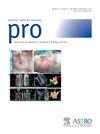F18-DCFPyL PSMA-PET/CT Versus MRI: Identifying the Prostate Cancer Region Most at Risk of Radiation Therapy Recurrence for Tumor Dose Escalation
IF 3.4
3区 医学
Q2 ONCOLOGY
引用次数: 0
Abstract
Purpose
Local recurrence of prostate cancer (PCa) after radiation therapy (RT) typically occurs at the site of dominant tumor burden, and recent evidence confirms that magnetic resonance imaging (MRI) guided tumor dose escalation improves outcomes. With the emergence of prostate-specific membrane antigen (PSMA) positron emission tomography (PET), we hypothesize that PSMA-PET and MRI may not equally depict the region most at risk of recurrence after RT.
Methods and Materials
Patients with intermediate- to high-risk PCa and MRI plus PSMA-PET performed before RT were identified. The sextant most at risk of recurrence was defined as the pathologically dominant region with peak biopsy percentage core length involvement and any sextant with ≥ 40% percentage core length involvement (pathologic gross tumor volume [pGTV], per prior work). Imaging methods were reviewed independently to compare GTVs with pGTVs most at risk of recurrence. A paired chi-square test was employed for analysis.
Results
Eighty-eight patients (n = 88) were identified. Overall, there were no differences in the sensitivity of MRI and PSMA-PET for identifying the pGTV most at risk of recurrence. However, PSMA-PET demonstrated a trend of improved sensitivity for high-risk PCa compared with MRI (n = 46, 96% vs 87%, P = .06), while MRI outperformed PSMA-PET for the intermediate-risk group (n = 42, 93% vs 81%, P = .03). PSMA-PET showed lower specificity, misidentifying GTV in uninvolved pathologic sextants for 12% of intermediate-risk patients, whereas MRI was faultless (12% vs 0%, P = .03). MRI and PSMA-PET each misidentified uninvolved sextants for 9% of patients in the high-risk group.
Conclusions
MRI demonstrates superior sensitivity in identifying the region most at risk of RT recurrence for intermediate-risk PCa, whereas PSMA-PET may add value for some high-risk patients. Informed by sextant biopsy information and MRI, clinicians should consider integrating PSMA-PET for patients with high-risk diseases when delineating GTVs.
F18-DCFPyL PSMA-PET/CT与MRI:确定放射治疗中肿瘤剂量增加复发风险最高的前列腺癌区域
目的:放射治疗(RT)后前列腺癌(PCa)的局部复发通常发生在主要肿瘤负荷部位,最近的证据证实磁共振成像(MRI)引导的肿瘤剂量递增可改善预后。随着前列腺特异性膜抗原(PSMA)正电子发射断层扫描(PET)的出现,我们假设PSMA-PET和MRI可能不能相同地描述RT后复发风险最大的区域。方法和材料:在RT前进行中至高风险PCa和MRI + PSMA-PET的患者。复发风险最高的六分仪被定义为病理上占主导地位的活检百分比核心长度受累的峰值区域和任何核心长度受累百分比≥40%的六分仪(病理总肿瘤体积[pGTV],根据先前的工作)。独立回顾影像学方法,比较gtv与复发风险最高的pgtv。采用配对卡方检验进行分析。结果:共确诊88例(n = 88)。总的来说,MRI和PSMA-PET在识别复发风险最大的pGTV方面的敏感性没有差异。然而,与MRI相比,PSMA-PET对高危PCa的敏感性有提高的趋势(n = 46, 96%对87%,P = 0.06),而MRI在中危组的表现优于PSMA-PET (n = 42, 93%对81%,P = 0.03)。PSMA-PET表现出较低的特异性,12%的中危患者在未受损伤的病理六分仪中错误识别GTV,而MRI则没有错误(12%对0%,P = 0.03)。在高危组中,MRI和PSMA-PET均有9%的患者未识别出相关的六分仪。结论:MRI在识别中危PCa RT复发风险最高的区域方面表现出更高的敏感性,而PSMA-PET对一些高危患者可能更有价值。根据六分仪活检信息和MRI,临床医生在划定gtv时应考虑将PSMA-PET用于高危疾病患者。
本文章由计算机程序翻译,如有差异,请以英文原文为准。
求助全文
约1分钟内获得全文
求助全文
来源期刊

Practical Radiation Oncology
Medicine-Radiology, Nuclear Medicine and Imaging
CiteScore
5.20
自引率
6.10%
发文量
177
审稿时长
34 days
期刊介绍:
The overarching mission of Practical Radiation Oncology is to improve the quality of radiation oncology practice. PRO''s purpose is to document the state of current practice, providing background for those in training and continuing education for practitioners, through discussion and illustration of new techniques, evaluation of current practices, and publication of case reports. PRO strives to provide its readers content that emphasizes knowledge "with a purpose." The content of PRO includes:
Original articles focusing on patient safety, quality measurement, or quality improvement initiatives
Original articles focusing on imaging, contouring, target delineation, simulation, treatment planning, immobilization, organ motion, and other practical issues
ASTRO guidelines, position papers, and consensus statements
Essays that highlight enriching personal experiences in caring for cancer patients and their families.
 求助内容:
求助内容: 应助结果提醒方式:
应助结果提醒方式:


